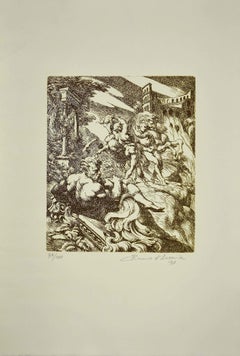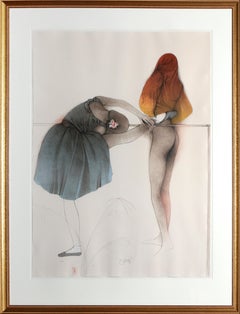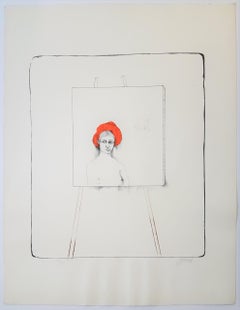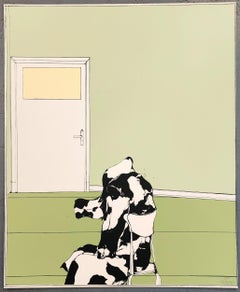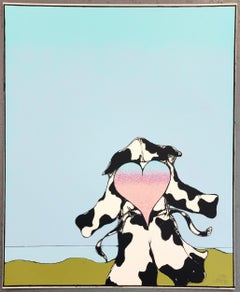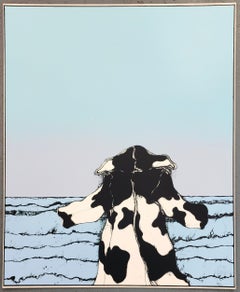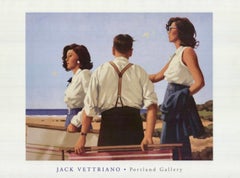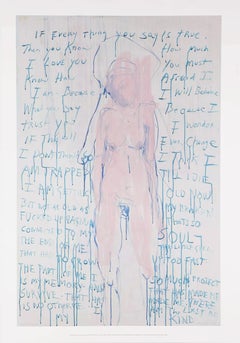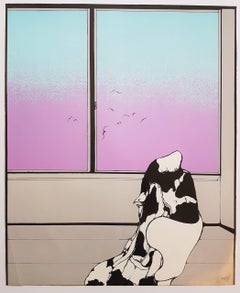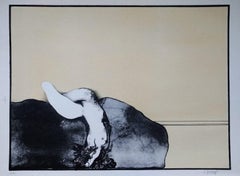Bruno Bruni Figurative Prints
Italian, b. 1935
Bruno Bruni senior (born 22 November 1935, in Gradara) is an Italian lithographer, graphic artist, painter and sculptor. He became commercially successful in the 1970s. In 1977, he won the International Senefeld award for Lithography. He has since become one of the most successful Italian artists in Germany and one of Germany's best known lithographers.
Born in Gradara, in the Province of Pesaro and Urbino on the Adriatic Coast in 1935, the son of a railway attendant, Bruni started painting as a young boy. He was initially a pupil of [Giuliano Vanghi] ; from 1953 to 1959 he attended the Art Institute in Pesaro. He then moved to London, where he became interested in pop art. In 1960, after an exhibit of his work at London's John Whibley Gallery, and after meeting a girl from Hamburg, he moved there to live with her and enrolled at the Hochschule für bildende Künste Hamburg. He has lived in the city ever since and visits his hometown regularly.
In the 1970s, Bruno Bruni made a name for himself as a draftsman, lithographer, painter and sculptor in the international art world. In 1977, he won the International Senefeld Competition for Lithography. He is influenced primarily by German expressionists like Otto Dix, George Grosz etc. and the Italian old masters . In particular, he is noted as one of the few lithographic artists "who paint all work directly onto the stone". He is especially known for his erotic female forms.[4] He has said, "I cannot paint an abstract picture. If I had gone along with the trends I'd have disappeared long ago". He resides in a converted swimming pool, more than a century old, which serves as apartment, workplace and gallery.[3] He sells his art through his wife's gallery in Hanover and is reputedly one of Germany's top earning artists. He is also a keen cook of Italian cuisine, and is a boxing fan and a close friend of former boxing champion Dariusz Michalczewski, for whom he used to cook for before matches. He has also cooked for Gerhard Schröder and has published a cooking book with his favorite recipes, memoirs and pictures related to his life.to
7
3
6
1
1
Overall Width
to
Overall Height
to
8
2
1
12
883
384
367
310
11
7
2
1
11
5
4
3
2
2
2
1
1
1
1
1
1
6
4
1
2
8
10
1
Artist: Bruno Bruni
Mythologic Figures - Etching by Bruno Bruni - 1997
By Bruno Bruni
Located in Roma, IT
Mythologic Figures is an original etching artwork, realized by Bruno Bruni called Bruno d'Arcevia in 1997.
Hand-signed and dated on the lower rig...
Category
1990s Contemporary Bruno Bruni Figurative Prints
Materials
Etching
Le Palmier, Modern Art Ballet Lithograph by Bruno Bruni 1983
By Bruno Bruni
Located in Long Island City, NY
In the 1970s, Bruno Bruni made a name for himself as a draftsman, lithographer, painter and sculptor in the international art world. In 1977, he won the International Senefeld Compet...
Category
1980s Contemporary Bruno Bruni Figurative Prints
Materials
Lithograph
Alla ricerca del tempo perduto
By Bruno Bruni
Located in Kansas City, MO
Bruno Bruni
Alla ricerca del tempo perduto
Year: 1967
Color Lithograph
Size: 22.6 x 19.5 in
Edition: 15
Signed, numbered and dated in pencil by the artist
Bruno Bruni senior is an I...
Category
1960s Modern Bruno Bruni Figurative Prints
Materials
Lithograph
$298 Sale Price
38% Off
Prego, s'accomodi
By Bruno Bruni
Located in Kansas City, MO
Bruno Bruni
Prego, s'accomodi
Year: 1969
Serigraph
Size: 29.5x24 inches
Signed, numbered and dated by hand
Edition: 99
Annotated verso
Publisher: Il Torcoliere, Rome, Italy
Printer: ...
Category
1960s Modern Bruno Bruni Figurative Prints
Materials
Screen
$480 Sale Price
40% Off
Io Vengo
By Bruno Bruni
Located in Kansas City, MO
Bruno Bruni
Io Vengo
Year: 1969
Serigraph
Size: 29.5x24 inches
Signed, numbered and dated by hand
Edition: 99
Annotated verso
Publisher: Il Torcoliere, Rome, Italy
Printer: Böer, Ham...
Category
1960s Modern Bruno Bruni Figurative Prints
Materials
Screen
$480 Sale Price
40% Off
Ritorno
By Bruno Bruni
Located in Kansas City, MO
Bruno Bruni
Ritorno
Year: 1969
Serigraph
Size: 29.5x24 inches
Signed, numbered and dated by hand
Edition: 99
Annotated verso
Publisher: Il Torcoliere, Rome, Italy
Printer: Böer, Hamb...
Category
1960s Modern Bruno Bruni Figurative Prints
Materials
Screen
$480 Sale Price
40% Off
Help
By Bruno Bruni
Located in Kansas City, MO
Bruno Bruni
Help
Year: 1969
Serigraph
Size: 29.5x24 inches
Signed, numbered and dated by hand
Edition: 99
Annotated verso
Publisher: Il Torcoliere, Rome, Italy
Printer: Böer, Hamburg...
Category
1960s Modern Bruno Bruni Figurative Prints
Materials
Screen
$478 Sale Price
40% Off
Melancholia
By Bruno Bruni
Located in Kansas City, MO
Bruno Bruni
Contemplazione
Year: 1969
Serigraph
Size: 29.5x24 inches
Signed, numbered and dated by hand
Edition: 99
Annotated verso
Publisher: Il Torcoliere, Rome, Italy
Printer: Böe...
Category
1960s Modern Bruno Bruni Figurative Prints
Materials
Screen
$480 Sale Price
40% Off
Al Quattro Large Surrealist Modernist Lithograph Embracing Couple
By Bruno Bruni
Located in Surfside, FL
Bruno Bruni senior (born 22 November 1935, in Gradara) is an Italian lithographer, graphic artist, painter and sculptor. He became commercially successful in the 1970s. In 1977, he won the International Senefeld award for Lithography. He has since become one of the most successful Italian artists in Germany and one of Germany's best known lithographers.
Born in Gradara, in the Province of Pesaro and Urbino on the Adriatic Coast in 1935, the son of a railway attendant, Bruni started painting as a young boy. He was initially a pupil of [Giuliano Vanghi] ; from 1953 to 1959 he attended the Art Institute in Pesaro. He then moved to London, where he became interested in pop art. In 1960, after an exhibit of his work at London's John Whibley Gallery, and after meeting a girl from Hamburg, he moved there to live with her and enrolled at the Hochschule für bildende Künste Hamburg. He has lived in the city ever since and visits his hometown regularly. In 1961-1966 took a course at the Hamburg College of Fine Arts, where at that time taught artists Georg Gresko, Paul Wunderlich, Horst Janssen, Arnolfo Hausner, and art critic Hans Theodor Flemming. One of his teachers called Bruni Renato Guttuso. He studied in Milan. Along with several young authors Bruni founded in Hamburg group "COOP" - against the commercialization of art. In the 1970s, Bruno Bruni made a name for himself as a draftsman, lithographer, painter and sculptor in the international art world. Bearing stylistic similarities to the surrealist work of Michael Parkes and Leonor Fini. In 1977, he won the International Senefeld Competition for Lithography. He is influenced primarily by German expressionists like Otto Dix, George Grosz etc. and the Italian old masters . In particular, he is noted as one of the few lithographic artists "who paint all work directly onto the stone". He is especially known for his erotic female forms. He has said, "I cannot paint an abstract picture. If I had gone along with the trends I'd have disappeared long ago". He resides in a converted swimming pool, more than a century old, which serves as apartment, workplace and gallery. He sells his art through his wife's gallery in Hanover and is reputedly one of Germany's top earning artists. He is also a keen cook of Italian cuisine, and is a boxing fan and a close friend of former boxing champion Dariusz Michalczewski, for whom he used to cook for before matches. He has also cooked for Gerhard Schröder and has published a cooking book...
Category
1980s Surrealist Bruno Bruni Figurative Prints
Materials
Lithograph
Modern Abstract Red & Purple Toned Figurative Lithograph of Nude Changing Woman
By Bruno Bruni
Located in Houston, TX
Modern abstract red and purple toned offset lithograph of a female figure by Italian artist Bruno Bruni. The work features a loosely rendered nude woman bent over in the process of c...
Category
Mid-20th Century Modern Bruno Bruni Figurative Prints
Materials
Lithograph
Melancholia
By Bruno Bruni
Located in Kansas City, MO
Bruno Bruni
Melancholia
Year: 1969
Serigraph
Size: 29.5x24 inches
Signed, numbered and dated by hand
Edition: 99
Annotated verso
Publisher: Il Torcoliere, Rome, Italy
Printer: Böer, Hamburg, Germany
COA provided
Ref.: 924802-1347
Bruno Bruni senior (born 22 November 1935, in Gradara, Italy) is an Italian lithographer, graphic artist, painter and sculptor. He became commercially successful in the 1970s. In 1977, he won the International Senefeld award for Lithography. He has since become one of the most successful Italian artists in Germany and one of Germany's best known lithographers.
Born in Gradara, in the Province of Pesaro and Urbino on the Adriatic Coast in 1935, the son of a railway attendant, Bruni started painting as a young boy. He was initially a pupil of Giuliano Vanghi; from 1953 to 1959 he attended the Art Institute in Pesaro. He then moved to London, where he became interested in pop art. In 1960, after an exhibit of his work at London's John Whibley Gallery, and after meeting a girl from Hamburg, he moved there to live with her and enrolled at the Hochschule für bildende Künste Hamburg. He has lived in the city ever since and visits his hometown regularly.
In the 1970s, Bruno Bruni made a name for himself as a draftsman, lithographer, painter and sculptor in the international art world. In 1977, he won the International Senefeld Competition for Lithography. He is influenced primarily by German expressionists like Otto Dix, George Grosz etc. and the Italian old masters . In particular, he is noted as one of the few lithographic artists "who paint all work directly onto the stone". He is especially known for his erotic female forms. He has said, "I cannot paint an abstract picture. If I had gone along with the trends I'd have disappeared long ago". He resides in a converted swimming pool, more than a century old, which serves as apartment, workplace and gallery. He sells his art through his wife's gallery in Hanover and is reputedly one of Germany's top earning artists. He is also a keen cook of Italian cuisine, and is a boxing fan and a close friend of former boxing champion Dariusz Michalczewski, for whom he used to cook for before matches. He has also cooked for Gerhard Schröder and has published a cooking book...
Category
1960s Modern Bruno Bruni Figurative Prints
Materials
Screen
$480 Sale Price
40% Off
Related Items
Young Hearts, Portland Gallery London offset lithograph
By Jack Vettriano
Located in Hillsborough, NC
Jack Vettriano (1951-) is renowned for his film noir oil paintings and 1930s glam style. Uniquely Vettriano, ‘Young Hearts’ is set by the seaside inviting narratives about the figures in his work: relationships, anticipation, power and suggestion.
Vettriano grew up by the Fife Scottish coast. He began painting beach scenes as a young adult, later developing his particular recognizable style and thematic imagery. His work was embraced by celebrities such as Madonna and Jack Nicholson and he has become hugely successful. His most famous painting, ‘The Singing Butler...
Category
Early 2000s Contemporary Bruno Bruni Figurative Prints
Materials
Lithograph, Offset
I Am The Last Of My Kind
By Tracey Emin
Located in London, GB
Published by the Royal Academy
Category
2010s Contemporary Bruno Bruni Figurative Prints
Materials
Lithograph, Offset
Two Columns (framed): colorful pop art abstracted Greek pillars Micheal Hurson
By Michael Hurson
Located in New York, NY
Pop art scene of abstracted Greek pillars and green leaves. Drawings in black and white, pale blue, red and grey compose this colorful print. Layers of p...
Category
1980s Contemporary Bruno Bruni Figurative Prints
Materials
Lithograph, Screen
$1,100
H 9.75 in W 7.5 in D 0.75 in
Original Pan American World Airways by Clipper to Portugal and Spain poster
By Jean Carlu
Located in Spokane, WA
Original vintage poster: Portugal and Spain by Pan American World Airways Clipper, Artist: Jean Carlu. Pan American original vintage poster large travel size format 27.5" x 41.1" Earliest version (the 1950s) of the poster for travel by Constellation aircraft.
Original linen-backed, Pan American World Airways by Clipper vintage poster for travel to Portugal and Spain. Wear and stress marks in the top and bottom dark area but are not tears.. Small touch-up on the left white border.
In the middle of this image, it features a matador with a cape hanging off his shoulder. Surrounding the image in vignettes of cut-out windows showing typical landscape scenes and castles. A great smaller format original for "The World's Most Experienced Airline". One of the windmills shown in this image has cloth sails. Trimming the sails allowed the windmill to turn at near the optimal speed in a large range of wind velocities. Pan American World Airways by Clipper.
Pan American a.k.a. Pan Am Airlines posters are very collectible and rare year to year. This a great design opportunity for a home with a European flair. The Pan Am Clipper...
Category
1950s American Modern Bruno Bruni Figurative Prints
Materials
Lithograph
$1,598
H 42 in W 27.5 in D 0.05 in
Untitled (Smile-ism No. 20)
By Yue Minjun
Located in Calabasas, CA
Artist: Yue Minjun
Title: Untitled (Smile-ism No. 20)
Year: 2006
Medium: Lithograph on Rives BFK paper
Edition: 45; signed and numbered in pencil
Sheet: 43.50 x 35.25 in. (110.5 x 8...
Category
Early 2000s Contemporary Bruno Bruni Figurative Prints
Materials
Lithograph
Rodeo Queen by Luis Jimenez
Located in Phoenix, AZ
Rodeo Queen, 1981
Edition 36/50
Signed lower left, Inscribed: for the "Rose" 82.
Provenance: Print was a gift to Rozanne Charington, companion and model for "Rodeo Queen", "Rose Tattoo" and "Jimenez at Adeliza's Candy Store".
Lithograph on paper
42 ½ × 29 in. (107.3 × 73.7 cm)
Luis Alfonso Jimenez
Born, 1940, El Paso, Texas, died 2006, Hondo, New Mexico.
Statement: Luis Jimenez, in his work, celebrates the vitality of life. . . . Jimenez es un hijo de la frontera; he knows its people and the landscape. It is the transformation of these people into art that is his most important contribution to the art of this vast region which stretches between Mexico and the United States.
His subject matter utilizes the popular images of the cultura del norte, and a large part of it is depicted and transformed in the rough and tumble world of la frontera. He is also a son of el norte, and so he uses its materials and explores its emerging, popular myths. The tension and attraction of Jimnez’s work is that he always creates within the space of his two worlds, the Mexicano and the Americano. He constantly shows us the irony of the two forces which repel, while showing us glimpses of the synthesis he seeks. What a gift it has been to us for this talented artist to reflect on the soul of our region. He gives meaning to our existence and history.
Rudolfo Anaya (passage chosen by the artist), A View from La Frontera, Man on Fire: Luis Jimenez, pp. 1, 3, 6Biography: Luis Jimenez was born in Texas to parents who had emigrated from Mexico to the United States; he would later dedicate his 1989 sculpture Border Crossing to his father, who had entered the country illegally. The elder Jimenez was a neon sign designer in El Paso, and Luis worked with him as a youth. His experience working in the neon shop and his fascination with U.S. car culture would both become major influences on his art career.
Jimenez studied architecture at the University of Texas, Austin (UTA), and also took art courses in which he first created sculptures with wood, steel, and fiberglass, choosing the latter because of its association with U.S. popular culture. He subsequently became one of the artists who made fiberglass an acceptable medium in the 1960s. In 1964 Jimenez received his B.S. in art from UTA, and he continued his studies at the Universidad Nacional Autonoma de Mexico in Mexico City.
In 1966 he moved to New York City and worked as an assistant to sculptor Seymour Lipton. Jimenez began to exhibit his art while in New York and in 1972 moved to New Mexico to focus on creating public sculptures, even as he maintained his diverse output of drawings, prints, and lithographs.
Drawing on his early experiences, Jimenez creates works that come from a border perspective, one that draws upon the hybridity bred by culture clashes. Often socially and politically informed, his works speak not only in regional terms, those germane to the southwestern United States, but to broader, more global issues as well. They exhibit a profoundly Chicano aesthetic and sensibility, one that is informed by Mexican and Mexican American traditions, North American popular culture, Chicano cultural icons, and images and themes unique to the Southwest. Death, sexuality, and the struggle of the common people are frequent themes.
Inspired by authors who write in an autobiographical style, Jimenez creates works that function as personal narrative yet are also able to make statements about culture in more global terms. His use of bold colors and lines, a legacy from his fathers work as a neon sign maker, lends a dynamic sensuality to his work, one that is particularly evident in his monumental fiberglass and acrylic urethane sculptural works
Many of Jimenez's works correspond to scholar Toms Ybarra-Fraustos definition of the Chicano aesthetic of rasquachismo, a lowbrow sensibility that appeals to the working class in that it applies to objects that subvert expressions of the mainstream or dominant culture. Creating art that speaks to the people, Jimenez is able to transform regional and culturally specific myths and symbols into globally recognized and relevant icons.
Exhibitions:
In addition to his personal work, Jimenez has been commissioned for numerous public art projects. In 1999 his sculpture Southwest Piet was designated a National Treasure by First Lady Hillary Clinton.
The many exhibitions featuring his work have included Human Concern/Personal Torment (Whitney Museum of American Art, New York, 1969).
The First International Motorcycle Art Show (Phoenix Art Museum, Phoenix, AZ, 1973).
Three Texas Artists (Centre Cultural Americaine, USIS, Paris, 1977),
Recent Trends in Collecting (Smithsonian Institution, Washington, DC, 1982).
Committed to Print (Museum of Modern Art, New York, 1989)
Printmaking in Texas: The 1980s (Modern Art Museum, Fort Worth, TX.
Laguna Gloria Art Museum, Austin, 1990.
The Whitney Biennial (Whitney Museum of American Art, New York, 1991)
Man On Fire: Luis Jimnez (Albuquerque Museum of Art, NM, 1994-95).
47th Annual Purchase Exhibition (American Academy of Arts and Letters, New York, 1995).
Traveling solo exhibition, Working Class Heroes: Images from the Popular Culture (1997-2000).
Jiménez
Collier Gallery has been in continuous operation for over 40 years. Originally located just off Main Street in downtown Scottsdale, Arizona, we have moved to Phoenix to accommodate and showcase our large inventory including:
• Original works by Maynard Dixon, Lon Megargee, Ed Mell, Fritz Scholder, Bill Schenck, Bill Lesch, Luis Jimenez, Greg
Singley, Dan Budnik, and other 20th century Western, WPA and Contemporary Southwestern artists.
• The Fine Art Estate of Lon Megargee
• Vintage rodeo...
Category
1980s Contemporary Bruno Bruni Figurative Prints
Materials
Lithograph
Original Algeciras Feria 1948 vintage Spanish travel lithograph poster
Located in Spokane, WA
Original vintage poster Algeciras Feria 1948 vintage Spanish travel poster. Archival linen backed in very fine condition, ready to frame. N...
Category
1940s American Modern Bruno Bruni Figurative Prints
Materials
Lithograph
$1,080 Sale Price
20% Off
H 39.5 in W 27.75 in D 0.05 in
Hand of Africa - Mandela, Former South African President, Signed Artwork, Hand
By Nelson Mandela
Located in Knowle Lane, Cranleigh
Nelson Mandela, Hand of Africa, Signed Limited Edition Lithograph
Many people are unaware that Nelson Mandela turned his hand to art in his 80's as a way of leaving a legacy for his ...
Category
Early 2000s Contemporary Bruno Bruni Figurative Prints
Materials
Lithograph
$20,636
H 25.5 in W 20 in D 2 in
Original For Every Fighter A Woman Worker, Y.W.C.A. vintage poster WW1
By Ernest Hamlin Baker
Located in Spokane, WA
For Every Fighter a Woman Worker. Original vintage poster. Linen Lined. Very good condition. Artist: Ernest Hamlin Baker. Size: 28" x 42". Year: 1918 Linen backed trimme...
Category
1910s American Modern Bruno Bruni Figurative Prints
Materials
Lithograph
$1,000 Sale Price
20% Off
H 42 in W 18 in D 0.05 in
Original Mardi Gras New Orleans 1978 festival serigraph poster
Located in Spokane, WA
Original Mardi Gras, New Orleans, 1978 linen-backed poster. Dressed up in what would be an American Indian costume with full headgear, he is holding a shield with a horse on it. Indian decoration on the footwear. Signed and numbered.
I believe this has to deal with Big Chief leading his Congo Nation Mardi Gras Indian group. Zulu Parade. Many of the original Mardi Gras jazz posters...
Category
1970s American Modern Bruno Bruni Figurative Prints
Materials
Screen
$636 Sale Price
20% Off
H 32 in W 23 in D 0.05 in
“Winter” from the “Four Seasons Suite” Series
By Alvar Sunol Munoz-Ramos
Located in San Francisco, CA
This embossed, numbered and signed lithograph, part of the “Four Seasons Suite,” is by Alvar Suñol Muñoz-Ramos (b. 1935), a renowned Spanish ar...
Category
1970s Modern Bruno Bruni Figurative Prints
Materials
Paper, Lithograph
$1,350
H 37.25 in W 30.5 in D 2 in
Vintage SIGNED Kitaj Poster, La Fabbrica, Milan (A Life 1975) woman in red dress
By Ronald Brooks Kitaj
Located in New York, NY
Printed in 1975, this poster features the encounter between an alluring woman dressed in red, and a man with his back to the viewer. The light of a streetlamp is beautifully imitated...
Category
Late 20th Century Modern Bruno Bruni Figurative Prints
Materials
Lithograph
Previously Available Items
Il Cappotto
By Bruno Bruni
Located in Kansas City, MO
Bruno Bruni
Il Cappotto
Year: 1969
Color Offset Lithograph
Size: 24 x 29.5 in.
Signed in the stone
COA provided
Bruno Bruni senior is an Italian lithographer, graphic artist, painte...
Category
1960s Modern Bruno Bruni Figurative Prints
Materials
Lithograph, Offset
Nude - Original Lithograph by Bruno Bruni - 1968
By Bruno Bruni
Located in Roma, IT
Nude is an original lithograph realized by Bruno Bruni in 1968. Hand signed in pencil on the lower right margin. Numbered in pencil on the lower left margin. Edition of 40 prints. Ve...
Category
1970s Contemporary Bruno Bruni Figurative Prints
Materials
Paper, Lithograph
Il Cappotto
By Bruno Bruni
Located in Kansas City, MO
Bruno Bruni
Il Cappotto
Year: 1969
Color Offset Lithograph
Size: 24 x 29.5 in.
Signed in the stone
Bruno Bruni senior is an Italian lithographer, graphic artist, painter and sculpto...
Category
1960s Modern Bruno Bruni Figurative Prints
Materials
Lithograph, Offset
Il Cappotto
By Bruno Bruni
Located in Kansas City, MO
Bruno Bruni
Il Cappotto
Year: 1969
Color Offset Lithograph
Size: 24 x 29.5 in.
Signed in the stone
Bruno Bruni senior is an Italian lithographer, graphic artist, painter and sculpto...
Category
1960s Modern Bruno Bruni Figurative Prints
Materials
Lithograph, Offset
Spettinata
By Bruno Bruni
Located in Kansas City, MO
Bruno Bruni
Spettinata
Year: 1967
Color Lithograph
Size: 50 x 70,50 cm
Edition: 30
Signed, numbered and dated in pencil by the artist
Bruno Bruni senior is an Italian lithographer, ...
Category
1960s Modern Bruno Bruni Figurative Prints
Materials
Lithograph
Al Quattro Large Surrealist Modernist Lithograph Embracing Couple
By Bruno Bruni
Located in Surfside, FL
Bruno Bruni senior (born 22 November 1935, in Gradara) is an Italian lithographer, graphic artist, painter and sculptor. He became commercially successful in the 1970s. In 1977, he won the International Senefeld award for Lithography. He has since become one of the most successful Italian artists in Germany and one of Germany's best known lithographers.
Born in Gradara, in the Province of Pesaro and Urbino on the Adriatic Coast in 1935, the son of a railway attendant, Bruni started painting as a young boy. He was initially a pupil of [Giuliano Vanghi] ; from 1953 to 1959 he attended the Art Institute in Pesaro. He then moved to London, where he became interested in pop art. In 1960, after an exhibit of his work at London's John Whibley Gallery, and after meeting a girl from Hamburg, he moved there to live with her and enrolled at the Hochschule für bildende Künste Hamburg. He has lived in the city ever since and visits his hometown regularly. In 1961-1966 took a course at the Hamburg College of Fine Arts, where at that time taught artists Georg Gresko, Paul Wunderlich, Horst Janssen...
Category
1980s Surrealist Bruno Bruni Figurative Prints
Materials
Lithograph
Bruno Bruni figurative prints for sale on 1stDibs.
Find a wide variety of authentic Bruno Bruni figurative prints available for sale on 1stDibs. You can also browse by medium to find art by Bruno Bruni in screen print, lithograph, etching and more. Much of the original work by this artist or collective was created during the 20th century and is mostly associated with the modern style. Not every interior allows for large Bruno Bruni figurative prints, so small editions measuring 17 inches across are available. Customers who are interested in this artist might also find the work of Fabrizio Clerici, Renzo Biasion, and Mane Katz. Bruno Bruni figurative prints prices can differ depending upon medium, time period and other attributes. On 1stDibs, the price for these items starts at $199 and tops out at $2,000, while the average work can sell for $480.
